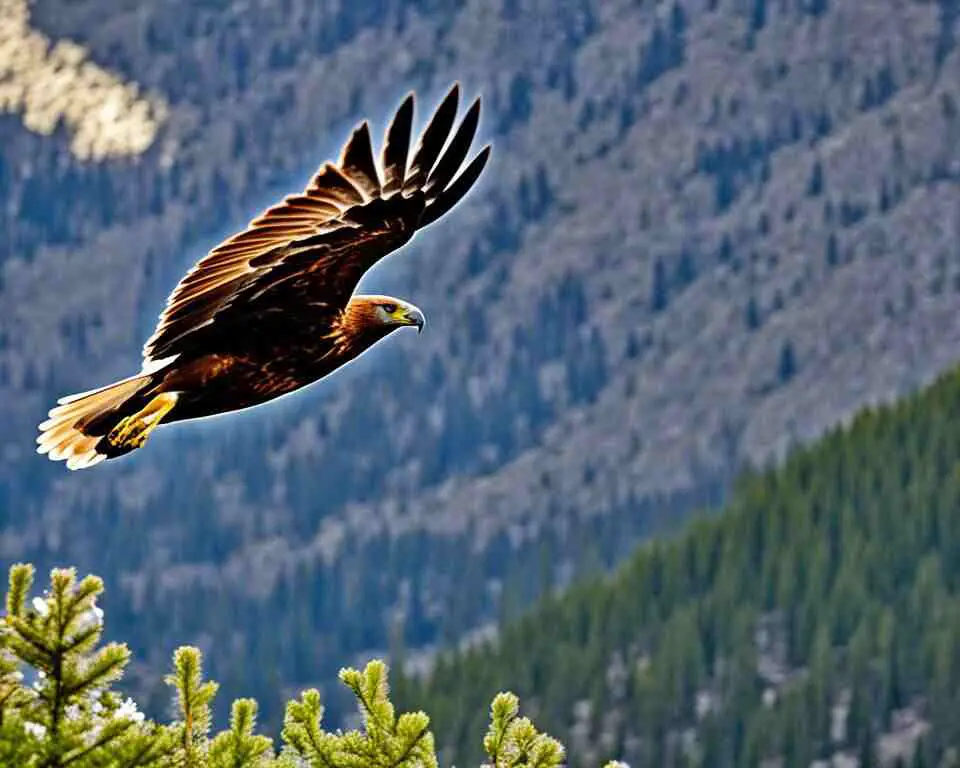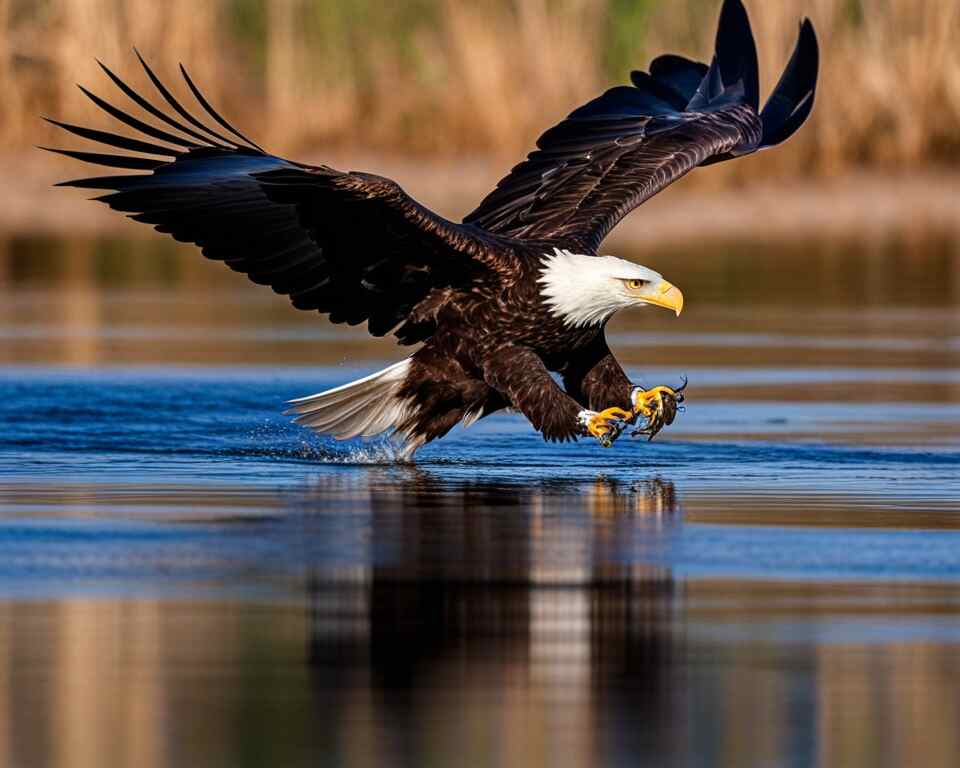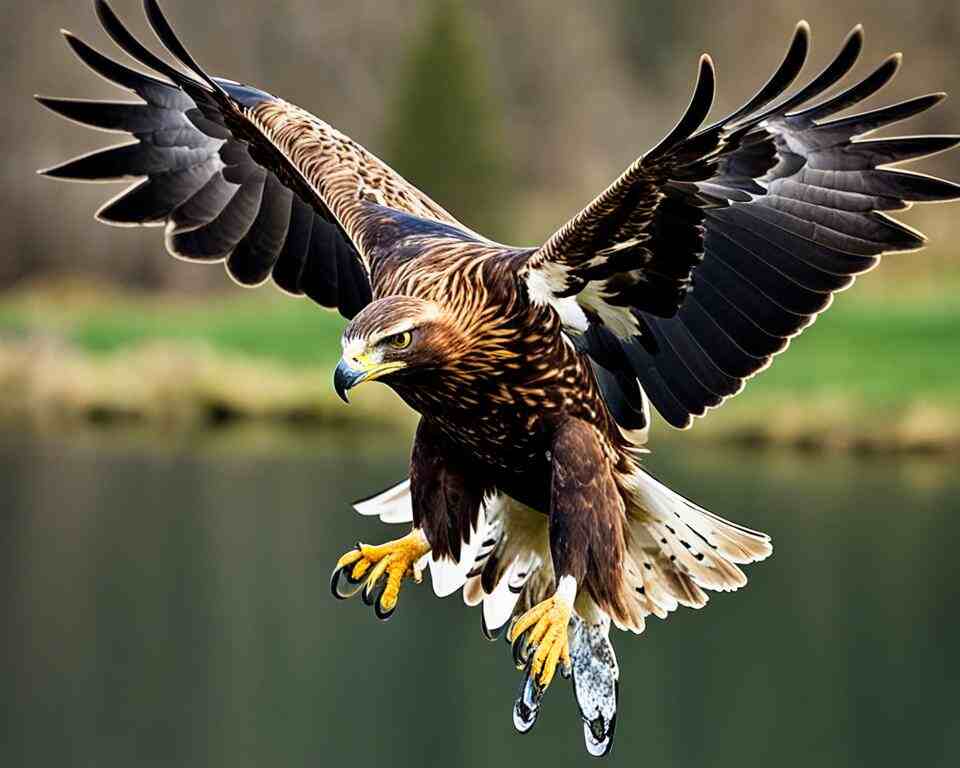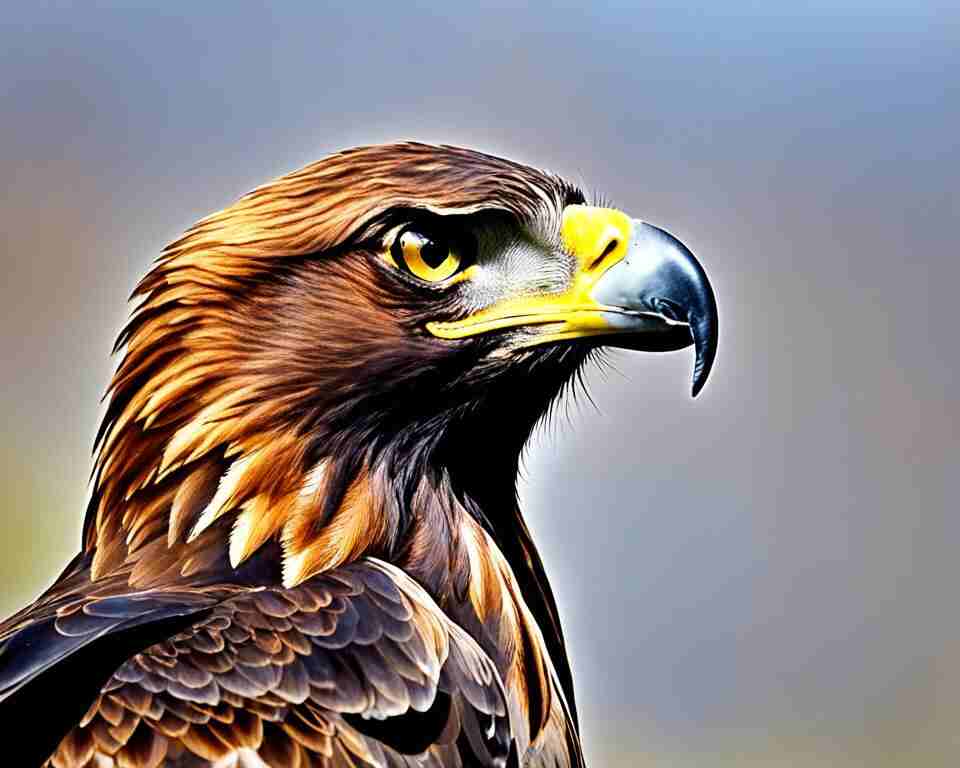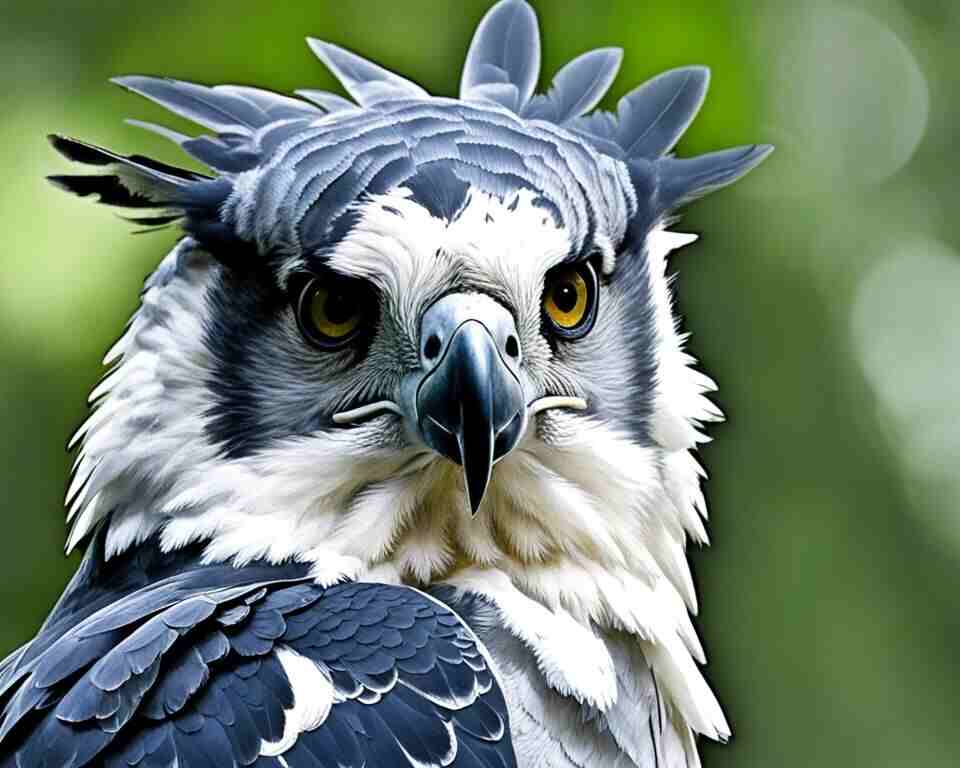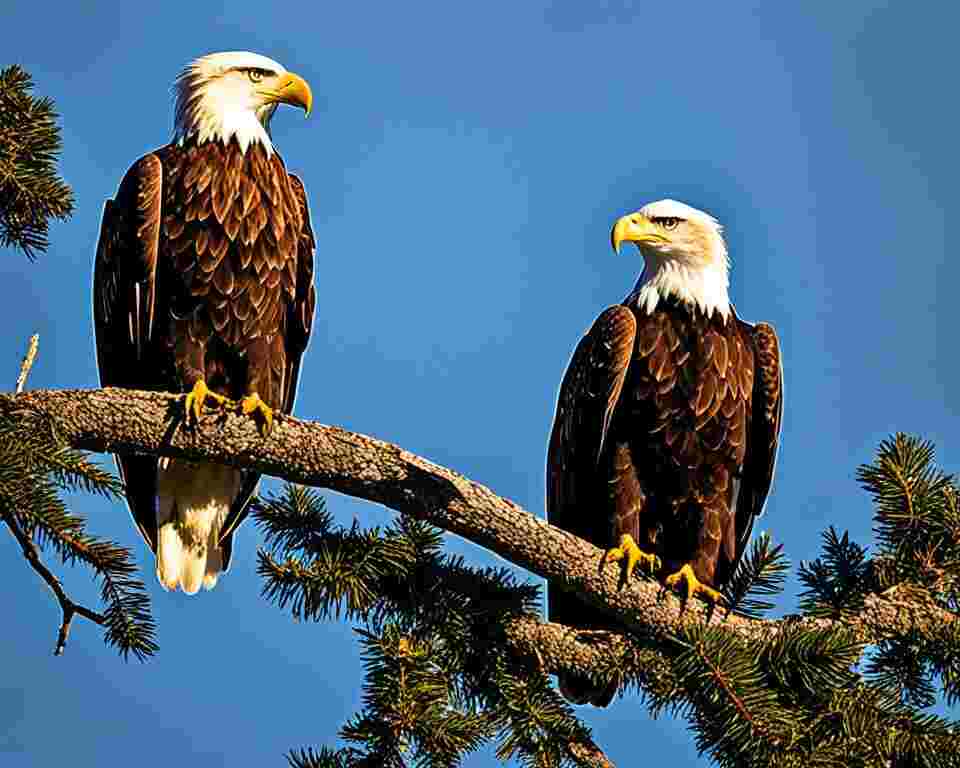Eagles are more than just symbols of strength and freedom—they’re nature’s elite predators. With fierce talons, laser-sharp eyesight, and jaw-dropping aerial skills, these raptors dominate the skies.
In this article, you’ll uncover 100 surprising eagle facts that reveal the secret lives of these majestic hunters. From their massive wingspans to unbelievable survival tactics, get ready to see eagles in a whole new light!
Click the Play button below to listen to our podcast:
Table of Contents
- 1 Introduction to Eagles
- 2 100 Fascinating Facts About Eagles
- 2.1 Eagle Families:
- 2.2 Number of Species:
- 2.3 Icon of Strength:
- 2.4 Wingspan:
- 2.5 Bald Eagles in North America:
- 2.6 Eyesight:
- 2.7 Long Lifespan:
- 2.8 Largest Eagle:
- 2.9 Diverse Range:
- 2.10 Breeding Season:
- 2.11 Sharp Talons:
- 2.12 Beak Strength:
- 2.13 Coloration:
- 2.14 Feathers for Soaring:
- 2.15 Body Size:
- 2.16 Golden Eagle Color:
- 2.17 Wing Flexibility:
- 2.18 Weight:
- 2.19 Nostrils:
- 2.20 Large Feet:
- 2.21 Dual Fovea:
- 2.22 UV Vision:
- 2.23 Binocular Vision:
- 2.24 Vision Distance:
- 2.25 High Resolution:
- 2.26 Night Vision:
- 2.27 Large Eyes:
- 2.28 Focus on Small Prey:
- 2.29 Adaptation to Climate:
- 2.30 Binocular Field:
- 2.31 Nesting Sites:
- 2.32 Nest Size:
- 2.33 Alaska’s Bald Eagles:
- 2.34 Coastal Living:
- 2.35 Golden Eagles’ Range:
- 2.36 Migratory Patterns:
- 2.37 Temperate Zones:
- 2.38 High Altitudes:
- 2.39 Cliffs Over Trees:
- 2.40 Ecological Impact:
- 2.41 Carnivorous Diet:
- 2.42 Fish-Eating Eagles:
- 2.43 Golden Eagles’ Prey:
- 2.44 Food Stealing:
- 2.45 Prey Size:
- 2.46 Hunting Techniques:
- 2.47 Fishing Talons:
- 2.48 Scavenger Behavior:
- 2.49 Hunting in Pairs:
- 2.50 Speed of Attack:
- 2.51 Nest Building:
- 2.52 Material Used:
- 2.53 One to Three Eggs:
- 2.54 Egg Incubation:
- 2.55 Parental Duties:
- 2.56 Fledging Time:
- 2.57 Parental Protection:
- 2.58 Eagle Chick Growth:
- 2.59 Multiple Generations:
- 2.60 Solitary Hunters:
- 2.61 Aggression:
- 2.62 Mating for Life:
- 2.63 Territorial Defense:
- 2.64 Communicative Calls:
- 2.65 Courtship Rituals:
- 2.66 Aggressive Courtship:
- 2.67 Cooperative Hunting:
- 2.68 Human-Eagle Interaction:
- 2.69 Communal Roosting:
- 2.70 Cruising Speed:
- 2.71 Diving Speed:
- 2.72 Thermal Soaring:
- 2.73 Efficient Gliders:
- 2.74 Flight Altitude:
- 2.75 Wind Riders:
- 2.76 Powerful Wingbeats:
- 2.77 Speed During Hunting:
- 2.78 First Flight:
- 2.79 High-Speed Attacks:
- 2.80 Endangered Species:
- 2.81 Conservation Efforts:
- 2.82 Habitat Protection:
- 2.83 International Laws:
- 2.84 Eagle Migration:
- 2.85 Eagle Recovery:
- 2.86 Poisoning Threats:
- 2.87 Wildlife Reserves:
- 2.88 Captivity Success:
- 2.89 Environmental Changes:
- 2.90 Roman Empire Symbol:
- 2.91 Symbol of Strength and Freedom:
- 2.92 Zeus’ Companion:
- 2.93 Bald Eagle as a National Emblem:
- 2.94 Heraldic Symbols:
- 2.95 Mayan Culture:
- 2.96 Christian Symbolism:
- 2.97 Royalty in Ancient Egypt:
- 2.98 Eagle Spirit Guides:
- 2.99 Modern Symbolism:
- 2.100 Cultural Reverence:
- 3 Common Eagle Species Facts
- 4 Conclusion
- 5 Author
Introduction to Eagles
Eagles are large, powerful birds of prey that belong to the Accipitridae family. With around 60 species, eagles are found on every continent except Antarctica. They are known for their impressive wingspans, sharp talons, and exceptional vision. These magnificent birds are revered around the world, symbolizing freedom, strength, and courage.
100 Fascinating Facts About Eagles
Eagle Families:
Eagles belong to the Accipitridae family, which also includes hawks, kites, and harriers. This family represents a diverse set of predators, each with unique hunting adaptations. The eagle’s larger size and more powerful hunting abilities give it an advantage over the other members of its family.
Number of Species:
Around 60 species of eagles are found across the globe, each inhabiting different continents and ecosystems. The diversity of eagles means they have adapted to various climates and diets, making them one of the most versatile bird species.
Icon of Strength:
Eagles are commonly symbols of power, freedom, and bravery. From ancient civilizations to modern emblems, eagles represent strength. This is due to their dominance in the sky, sharp hunting skills, and majestic appearance.
Wingspan:
The White-tailed Eagle (Haliaeetus albicilla) has the largest wingspan of any eagle, reaching up to 8.6 feet (2.62 m). The Steller’s Sea Eagle (Haliaeetus pelagicus) also has an impressive wingspan, reaching 8.2 feet (2.5 m), making it one of the largest eagles in the world.
Bald Eagles in North America:
The Bald Eagle, the national bird of the United States, symbolizes freedom and independence. Its near-extinction in the 20th century is a testament to the impact of human activity, but conservation efforts have successfully brought their population back from the brink.
Eyesight:
An eagle’s eyesight is 4 to 8 times sharper than a human’s, allowing them to spot prey from 3 miles away. This incredible vision is one of their most important adaptations for hunting and survival.
Long Lifespan:
Eagles live for 20-30 years in the wild, with some living over 50 years in captivity. This longevity allows them ample time to master their hunting techniques and pass on those skills to future generations.
Largest Eagle:
The Steller’s Sea Eagle weighs up to 20 pounds, making it the heaviest eagle species. Their size and powerful hunting techniques make them top predators in their environment.
Diverse Range:
Eagles are found on every continent except Antarctica. Whether it’s the cold regions of North America or the deserts of Africa, eagles have adapted to a wide range of climates.
Breeding Season:
Eagles breed in late winter or early spring, depending on their geographic location. During this time, they are highly territorial and aggressively defend their nesting sites from other predators.
Sharp Talons:
An eagle’s talons can exert 400-1000 pounds per square inch of pressure, depending on the species. This strength is essential for grabbing and holding onto prey, including fish, mammals, and even other birds.
Beak Strength:
Eagles have strong, hooked beaks that are perfectly designed for tearing flesh from their prey. This beak design allows them to efficiently consume large animals.
Coloration:
Most eagles have dark brown or black feathers with lighter heads and tails. The Bald Eagle, for example, has a striking white head and tail, contrasting with its dark body.
Feathers for Soaring:
Eagles have long, broad wings that allow them to soar and glide for long distances. This design is perfect for covering large areas in search of prey without expending too much energy.
Body Size:
Male eagles are typically smaller than females. This size difference is common in many bird species, with females often being the larger and more dominant sex.
Golden Eagle Color:
Golden Eagles have dark brown feathers with golden-brown plumage on their heads and necks. Their distinctive coloration makes them one of the most easily recognized eagle species.
Wing Flexibility:
Eagles can adjust their wings for rapid turns and dives. This flexibility allows them to chase prey with agility, even at high speeds.
Weight:
The average weight of an eagle ranges from 6 to 15 pounds, depending on the species. The largest eagles, like the Steller’s Sea Eagle, can weigh as much as 20 pounds.
Nostrils:
Eagles have nostrils (nares) on their beaks, which allow them to breathe efficiently during flight. While they don’t filter out dust and debris, eagles rely on their nictitating membrane to protect their eyes from wind and airborne particles.
Large Feet:
Eagle feet can be around 3 to 4 inches in size, perfect for gripping onto prey or perching on branches. Their powerful feet help them maintain control while hunting or defending their nests.
Dual Fovea:
Eagles do have two foveas per eye, but they do not focus on two objects at once. Instead, one fovea is used for forward vision, while the other enhances long-distance vision.
UV Vision:
Eagles can see ultraviolet light, which is invisible to humans. This ability helps them detect prey that might be camouflaged or harder to spot with regular vision.
Binocular Vision:
Eagles have forward-facing eyes, providing them with exceptional depth perception. This allows them to judge distances accurately when swooping down to catch prey.
Vision Distance:
Eagles can spot prey from up to 3 miles away, a feat that few other animals can match. Their exceptional vision is crucial for their hunting success.
High Resolution:
An eagle’s eyes are so sharp that they can identify individual animals, like rabbits or fish, from great heights. This high-resolution vision helps them hunt from far distances.
Night Vision:
Eagles have superior vision during daylight but struggle in low-light conditions. Unlike owls, they are diurnal and rely on daylight for hunting.
Large Eyes:
An eagle’s eye is larger than the size of its brain, which is a key factor in their exceptional vision. Their large eyes are necessary for focusing on small prey from a great distance.
Focus on Small Prey:
Eagles are skilled at spotting small prey, such as mice or fish, even when it is camouflaged in its environment. Their sharp vision allows them to pick out details from hundreds of feet in the air.
Adaptation to Climate:
Eagles have developed specialized adaptations to survive in various climates, from the freezing temperatures of the Arctic to the scorching heat of the desert.
Binocular Field:
Eagles use binocular and monocular vision for depth perception, helping them judge distances accurately while diving for prey. However, their peripheral vision is narrower than that of some other raptors.
Nesting Sites:
Eagles typically build their nests in tall trees or on cliffs, often in remote areas. The height of their nests offers protection from predators and provides a clear view of the surrounding area to keep an eye on any potential threats.
Nest Size:
An eagle’s nest can weigh up to 1,000 pounds, making them one of the largest nests built by any bird species. This massive size allows them to accommodate their young as they grow, providing a secure environment for the chicks.
Alaska’s Bald Eagles:
Alaska is home to the largest population of Bald Eagles, with more than 30,000 individuals. The state’s abundance of rivers, lakes, and coastal habitats makes it the perfect environment for these magnificent birds to thrive.
Coastal Living:
Many eagle species, such as the Bald Eagle, prefer to live near bodies of water, including rivers, lakes, and coastlines. This is because water bodies provide abundant food sources like fish, which form a large part of their diet.
Golden Eagles’ Range:
Golden Eagles are found across North America, Europe, northern Africa and Asia, with a preference for mountainous regions. Their range spans vast areas, from the Rockies to the Alps, offering both the space and the prey necessary to support their hunting lifestyle.
Migratory Patterns:
Some species of eagles, including the Steppe Eagle, are migratory and travel across continents. They may migrate over 10,000 miles each year, crossing diverse landscapes to find food and suitable breeding areas.
Temperate Zones:
Eagles are found in temperate and arctic zones, where cooler climates prevail. They are well-adapted to these regions, with specialized plumage and hunting techniques that help them thrive in more challenging environments.
High Altitudes:
Golden Eagles are commonly found at high altitudes, such as in the Rocky Mountains or the Alps. Their powerful wings and sharp vision allow them to navigate rugged, elevated terrains while hunting for small mammals and other prey.
Cliffs Over Trees:
While Bald Eagles prefer nesting in tall trees, Golden Eagles often choose cliffs, rugged terrains and may also use trees for their nests. This difference in nesting preference is linked to the environments they inhabit, where cliffs provide better visibility and protection from predators.
Ecological Impact:
Eagles play a crucial role in maintaining ecological balance. By controlling populations of small animals and scavengers, they help regulate the food chain, preventing overpopulation of certain species.
Carnivorous Diet:
Eagles are strictly carnivores and primarily feed on fish, small mammals, and other birds. Their powerful talons and beaks make them efficient predators, capable of capturing prey much larger than themselves.
Fish-Eating Eagles:
Bald Eagles, in particular, have a strong affinity for fish. They spend much of their time near rivers and lakes, where they swoop down to catch fish with their sharp talons, often plucking prey directly from the water’s surface.
Golden Eagles’ Prey:
Golden Eagles hunt a wider variety of prey, including small mammals like rabbits, hares, and even larger animals like foxes. Their ability to take down such diverse prey makes them highly adaptable in various habitats.
Food Stealing:
Eagles, especially Bald Eagles, are known to steal food from other birds, such as ospreys or vultures. This behavior is often seen when an eagle observes another bird with a successful catch and swoops in to steal the meal.
Prey Size:
Eagles have been known to take down prey as large as a small deer or other medium-sized mammals. Their powerful talons and keen eyesight allow them to target even larger prey, making them formidable predators.
Hunting Techniques:
Eagles typically hunt by soaring high in the sky, scanning the ground for prey. Once they spot something, they dive at incredible speeds, sometimes reaching 100 miles per hour, to snatch the prey with their talons.
Fishing Talons:
Bald Eagles possess long, curved talons that are perfectly designed for catching and holding onto slippery fish. These talons can grip tightly onto their prey, even as it struggles to escape.
Scavenger Behavior:
While eagles are skilled hunters, they will also scavenge when the opportunity arises. They often feed on carrion left behind by other predators, ensuring that nothing goes to waste in their environment.
Hunting in Pairs:
While most eagle species hunt alone, Bald Eagles have been observed hunting in groups or pairs when food is abundant. This cooperative hunting behavior helps them tackle larger prey or hunt more effectively in certain environments.
Speed of Attack:
Eagles are among the fastest birds in the world, with some species diving at speeds of up to 200 miles per hour to catch prey mid-flight. This speed is critical for catching fast-moving prey, such as fish or small mammals.
Nest Building:
Eagles are known for their impressive nest-building skills. They use large sticks, moss, feathers, and other materials to construct their nests, which can grow up to 10 feet in diameter and 5 feet in depth if used and expanded over many years. These large nests provide a safe space for eagle chicks to grow and fledge.
Material Used:
Eagle nests are often made from materials found in their environment, including sticks, moss, and leaves. They are built to last and are often reused for several years, with new layers of materials added each season.
One to Three Eggs:
Eagles usually lay between one and three eggs per breeding season. Both parents take turns incubating the eggs, ensuring they stay warm and protected until they hatch.
Egg Incubation:
It takes about 35-38 days for an eagle egg to hatch. During this period, both the male and female share the responsibility of incubating the eggs, with each parent taking turns keeping the eggs warm.
Parental Duties:
Eagle parents share the responsibility of hunting, protecting the nest, and feeding their chicks. Both parents work together to ensure the survival and well-being of their young.
Fledging Time:
Eaglets typically fledge, or take their first flight, at around 12 weeks of age. However, they may continue to stay close to their parents for several months after fledging as they learn to hunt and survive on their own.
Parental Protection:
Eagle parents are fiercely protective of their nests and will not hesitate to defend them from intruders, including other eagles, large predators, or even humans. Their aggressive defense is vital for ensuring the safety of their young.
Eagle Chick Growth:
Eagle chicks grow rapidly, doubling in size within the first few weeks of life. Their parents feed them a steady diet of fresh meat, which helps them grow strong and ready for flight.
Multiple Generations:
Eagles often reuse their nests year after year, adding new materials to accommodate their growing families. This recycling of nests allows the parents to provide a stable and familiar environment for their offspring.
Solitary Hunters:
Most eagle species prefer to hunt alone. They are highly territorial and prefer solitary hunting to avoid competition with other birds. However, some species, like Bald Eagles, will form small groups when food is plentiful.
Aggression:
Eagles are known for their territorial aggression. They will aggressively defend their hunting grounds, nests, and mates from other eagles and potential threats, using their sharp talons and powerful beaks.
Mating for Life:
Many eagle species, including the Bald Eagle, mate for life. Once a pair has formed, they typically stay together and share the responsibilities of raising their young throughout their lives.
Territorial Defense:
Eagles are highly territorial birds. They will fiercely defend their nesting sites from other eagles and predators, sometimes engaging in aerial battles to establish dominance over a territory.
Communicative Calls:
Eagles use a variety of vocalizations, such as whistles, chirps, and screeches, to communicate with each other. These calls serve different purposes, from signaling a mate to warning off intruders.
Courtship Rituals:
During courtship, eagles engage in dramatic aerial displays, such as synchronized flying and food sharing. These rituals help the pair solidify their bond and ensure they are a strong, cooperative team for raising chicks.
Aggressive Courtship:
During courtship, eagles may perform a breathtaking aerial maneuver known as a “sky dance.” This involves the pair locking talons mid-air and spiraling downward, a thrilling display that strengthens their bond and showcases their strength and coordination.
Cooperative Hunting:
Although most eagle species hunt alone, some species, like the Bald Eagle, have been observed hunting cooperatively in groups, particularly when food is abundant. This rare behavior is particularly useful when they are hunting large prey or in challenging environments where teamwork provides an advantage.
Human-Eagle Interaction:
In remote areas, eagles may display curiosity toward people, especially when people are observing them from a distance. In certain situations, young or rehabilitated eagles have been known to approach humans, though they typically avoid direct interaction.
Communal Roosting:
While eagles are generally solitary, during winter months, they may gather in large groups called roosts. These communal gatherings allow eagles to conserve body heat by sharing warmth and offer a safe environment for resting in harsh conditions.
Cruising Speed:
When flying, eagles typically cruise at speeds of 30 to 35 miles per hour. Their broad wings and powerful muscles allow them to maintain steady, energy-efficient flight over long distances, scanning the landscape for potential prey.
Diving Speed:
Eagles are powerful hunters, and some species, like the golden eagle, can reach speeds of up to 200 miles per hour in a dive. This high-speed stoop is crucial for catching fast-moving prey, such as rabbits and other small mammals.
Thermal Soaring:
Eagles are masters of thermal soaring, a technique in which they use rising warm air currents to gain altitude without flapping their wings. This energy-saving method allows them to cover great distances with little effort, making it ideal for migration.
Efficient Gliders:
Eagles are highly efficient gliders, able to stay aloft for hours without flapping their wings. By taking advantage of air currents, they can travel vast distances while expending minimal energy.
Flight Altitude:
Eagles are capable of soaring at impressive altitudes. Some species, like the Golden Eagle, can reach heights exceeding 15,000 feet, especially during migration, providing them with an excellent vantage point for spotting prey below.
Wind Riders:
Eagles are experts at riding the wind. By utilizing wind currents, they can conserve energy and soar for extended periods. This ability allows them to cover vast territories and find food while using minimal physical effort.
Powerful Wingbeats:
Despite their large size, eagles are capable of powerful wingbeats when needed. Whether gaining altitude, pursuing prey, or navigating rough terrain, their strong wings provide them with the strength necessary for quick, efficient movements.
Speed During Hunting:
When hunting, eagles can dramatically increase their speed to catch fast-moving prey. Whether targeting fish, birds, or small mammals, some species, like the golden eagle, can reach speeds of up to 200 miles per hour in a high-speed dive.
First Flight:
Eaglets typically take their first flight, called fledging, at around 12 weeks of age. However, even after their first flight, they may stay close to their parents for several months, learning essential survival skills and practicing their flying techniques.
High-Speed Attacks:
Eagles are known for their lightning-fast attacks. When targeting prey, they dive from great heights at astonishing speeds, often catching their quarry mid-air or just above the ground, making them highly efficient hunters.
Endangered Species:
Some eagle species, such as the Philippine Eagle, are critically endangered. Habitat loss, hunting, and human-wildlife conflict have significantly reduced their numbers. Conservation efforts are crucial for ensuring their survival.
Conservation Efforts:
Conservation efforts have led to remarkable successes, such as the recovery of the Bald Eagle population. Laws banning harmful pesticides, like DDT, and habitat protection measures have allowed eagle populations to bounce back in certain areas.
Habitat Protection:
Eagles depend on large, undisturbed habitats to thrive. Protecting these areas—whether by creating wildlife reserves or enforcing environmental laws—ensures the safety of their nesting and feeding grounds, which is vital for their survival.
International Laws:
Eagles are protected under numerous international laws and agreements aimed at ensuring their conservation. In the U.S., for example, the Bald Eagle is safeguarded by the Bald and Golden Eagle Protection Act, which prohibits harming or disturbing these birds.
Eagle Migration:
Many eagle species are migratory, traveling thousands of miles each year to find food or suitable breeding grounds. This migration is driven by changing weather patterns, seasonal prey availability, and reproductive needs.
Eagle Recovery:
The Bald Eagle population, once critically endangered, has made an impressive recovery. Due to conservation programs, including bans on harmful chemicals and habitat restoration efforts, the Bald Eagle was removed from the U.S. endangered species list in 2007.
Poisoning Threats:
Eagles face significant threats from poisoning, both from ingesting pesticides like DDT and from hunting traps set for other animals. These threats can weaken their immune systems, interfere with their reproductive abilities, and sometimes even lead to death.
Wildlife Reserves:
Numerous countries have established wildlife reserves and sanctuaries specifically to protect eagle populations. These protected areas provide a safe space for eagles to breed, feed, and live without the threat of human disturbance.
Captivity Success:
Some eagles, especially those that have been injured or orphaned, are rehabilitated in captivity. Once recovered, many are successfully released back into the wild, where they can resume their natural behaviors and contribute to the population.
Environmental Changes:
Climate change is having a significant impact on eagle populations. As temperatures rise and habitats shift, some eagle species may find it harder to locate food, especially if their prey migrates or becomes less abundant.
Roman Empire Symbol:
The eagle was a powerful symbol of the Roman Empire, representing military strength and authority. Roman legions carried the eagle emblem into battle, and it became a lasting symbol of imperial power throughout history.
Symbol of Strength and Freedom:
In many Native American cultures, the eagle is a sacred symbol representing strength, freedom, and courage. It is often seen as a spiritual guide, offering protection and wisdom to those who honor it.
Zeus’ Companion:
In Greek mythology, the golden eagle was a companion to Zeus, the king of the gods. The eagle represented Zeus’ divine power and was often depicted as his messenger or symbol of his authority.
Bald Eagle as a National Emblem:
Since 1782, the Bald Eagle has served as the national bird and emblem of the United States. It is revered as a symbol of freedom, independence, and the strength of the American spirit.
Heraldic Symbols:
Eagles are commonly featured in heraldic symbols across various cultures. They represent nobility, power, and sovereignty, often appearing in royal coats of arms or on flags.
Mayan Culture:
In ancient Mayan culture, the eagle was associated with the sun, representing divine qualities and a connection to the gods. It was seen as a powerful creature with the ability to transcend earthly limitations.
Christian Symbolism:
In Christianity, the eagle symbolizes spiritual strength and protection. It is often seen as a guardian figure, offering divine protection and guidance to the faithful.
Royalty in Ancient Egypt:
In ancient Egypt, the eagle was a symbol of royalty and power. It was often depicted in the art and mythology surrounding Egyptian pharaohs, reinforcing the divine nature of their reign.
Eagle Spirit Guides:
In many cultures, the eagle is believed to serve as a spirit guide. It is thought to offer wisdom, protection, and a connection to the higher realms, helping individuals navigate life’s challenges.
Modern Symbolism:
Today, eagles are still widely used as symbols for national emblems, corporate logos, and military insignia. Their image continues to evoke strength, independence, and freedom across the world.
Cultural Reverence:
Across cultures and throughout history, the eagle has remained a symbol of reverence and awe. Its majestic flight, sharp vision, and hunting prowess have solidified its place as one of the most admired creatures on Earth.
Common Eagle Species Facts
| Eagle Species | Scientific Name | Habitat | Size | Diet | Lifespan |
|---|---|---|---|---|---|
| Bald Eagle | Haliaeetus leucocephalus | North America | 28-40 inches (71-101 cm) tall, 6-14 lbs (2.7-6.4 kg) weight, 6.5-7.5 ft (2-2.3 m) wingspan | Fish, waterfowl, small mammals, carrion | 20-30 years |
| Golden Eagle | Aquila chrysaetos | North America, Europe, Asia | 27-33 inches (69-84 cm) tall, 6.5-15 lbs (3-7 kg) weight, 6-7.5 ft (1.8-2.3 m) wingspan | Rabbits, hares, rodents, reptiles, birds, carrion | Up to 32 years |
| Harpy Eagle | Harpia harpyja | Central and South America | 35-41 inches (89-104 cm) tall, 9-20 lbs (4-9 kg) weight, 6.5-7.5 ft (2-2.3 m) wingspan | Monkeys, sloths, other mammals, birds | Up to 25 years |
| African Fish Eagle | Haliaeetus vocifer | Africa | 27-31 inches (68-78 cm) tall, 4-7 lbs (1.8-3.2 kg) weight, 6-8 ft (1.8-2.4 m) wingspan | Fish, waterbirds | 20-30 years |
| Steller’s Sea Eagle | Haliaeetus pelagicus | Russia, Japan, Korea | 36-40 inches (91-102 cm) tall, 15-20 lbs (6.8-9.1 kg) weight, 7-8 ft (2.1-2.4 m) wingspan | Fish, waterbirds, small mammals, carrion | Up to 30 years |
| White-tailed Eagle | Haliaeetus albicilla | Europe, Asia | 28-37 inches (71-94 cm) tall, 6-15 lbs (2.7-6.8 kg) weight, 7-8 ft (2.1-2.4 m) wingspan | Fish, waterbirds, carrion | Up to 25 years |
| Martial Eagle | Polemaetus bellicosus | Africa | 32-39 inches (81-99 cm) tall, 6-14 lbs (2.7-6.4 kg) weight, 6.5-8 ft (2-2.4 m) wingspan | Small mammals, birds, reptiles | Up to 20 years |
Note: The eagles listed in the table are some of the most common species of eagles found around the world. However, there are many other species of eagles that are not included in the table.
Conclusion
Eagles are not only powerful birds of prey but also deeply symbolic creatures, revered in cultures across the world. Their fascinating physical attributes, hunting skills, and cultural significance make them truly remarkable animals. Whether you’re a birdwatching enthusiast or just interested in learning more about these majestic birds, these 100 facts about eagles offer a detailed look into the lives of these incredible creatures.
Related Post:



